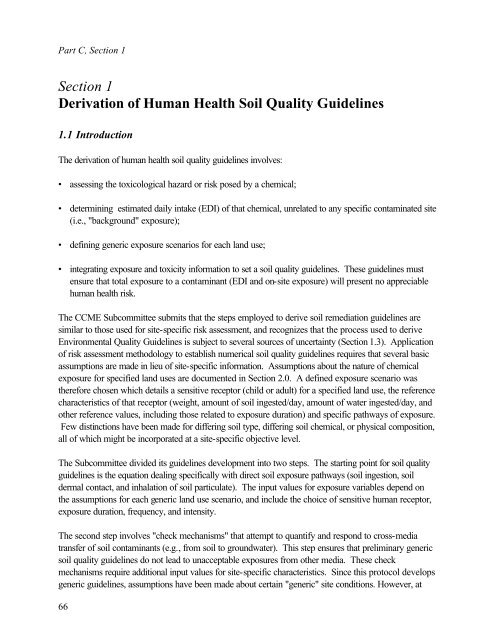Protocol for the Derivation of Environmental and Human ... - CCME
Protocol for the Derivation of Environmental and Human ... - CCME
Protocol for the Derivation of Environmental and Human ... - CCME
You also want an ePaper? Increase the reach of your titles
YUMPU automatically turns print PDFs into web optimized ePapers that Google loves.
Part C, Section 1<br />
Section 1<br />
<strong>Derivation</strong> <strong>of</strong> <strong>Human</strong> Health Soil Quality Guidelines<br />
1.1 Introduction<br />
The derivation <strong>of</strong> human health soil quality guidelines involves:<br />
• assessing <strong>the</strong> toxicological hazard or risk posed by a chemical;<br />
• determining estimated daily intake (EDI) <strong>of</strong> that chemical, unrelated to any specific contaminated site<br />
(i.e., "background" exposure);<br />
• defining generic exposure scenarios <strong>for</strong> each l<strong>and</strong> use;<br />
• integrating exposure <strong>and</strong> toxicity in<strong>for</strong>mation to set a soil quality guidelines. These guidelines must<br />
ensure that total exposure to a contaminant (EDI <strong>and</strong> on-site exposure) will present no appreciable<br />
human health risk.<br />
The <strong>CCME</strong> Subcommittee submits that <strong>the</strong> steps employed to derive soil remediation guidelines are<br />
similar to those used <strong>for</strong> site-specific risk assessment, <strong>and</strong> recognizes that <strong>the</strong> process used to derive<br />
<strong>Environmental</strong> Quality Guidelines is subject to several sources <strong>of</strong> uncertainty (Section 1.3). Application<br />
<strong>of</strong> risk assessment methodology to establish numerical soil quality guidelines requires that several basic<br />
assumptions are made in lieu <strong>of</strong> site-specific in<strong>for</strong>mation. Assumptions about <strong>the</strong> nature <strong>of</strong> chemical<br />
exposure <strong>for</strong> specified l<strong>and</strong> uses are documented in Section 2.0. A defined exposure scenario was<br />
<strong>the</strong>re<strong>for</strong>e chosen which details a sensitive receptor (child or adult) <strong>for</strong> a specified l<strong>and</strong> use, <strong>the</strong> reference<br />
characteristics <strong>of</strong> that receptor (weight, amount <strong>of</strong> soil ingested/day, amount <strong>of</strong> water ingested/day, <strong>and</strong><br />
o<strong>the</strong>r reference values, including those related to exposure duration) <strong>and</strong> specific pathways <strong>of</strong> exposure.<br />
Few distinctions have been made <strong>for</strong> differing soil type, differing soil chemical, or physical composition,<br />
all <strong>of</strong> which might be incorporated at a site-specific objective level.<br />
The Subcommittee divided its guidelines development into two steps. The starting point <strong>for</strong> soil quality<br />
guidelines is <strong>the</strong> equation dealing specifically with direct soil exposure pathways (soil ingestion, soil<br />
dermal contact, <strong>and</strong> inhalation <strong>of</strong> soil particulate). The input values <strong>for</strong> exposure variables depend on<br />
<strong>the</strong> assumptions <strong>for</strong> each generic l<strong>and</strong> use scenario, <strong>and</strong> include <strong>the</strong> choice <strong>of</strong> sensitive human receptor,<br />
exposure duration, frequency, <strong>and</strong> intensity.<br />
The second step involves "check mechanisms" that attempt to quantify <strong>and</strong> respond to cross-media<br />
transfer <strong>of</strong> soil contaminants (e.g., from soil to groundwater). This step ensures that preliminary generic<br />
soil quality guidelines do not lead to unacceptable exposures from o<strong>the</strong>r media. These check<br />
mechanisms require additional input values <strong>for</strong> site-specific characteristics. Since this protocol develops<br />
generic guidelines, assumptions have been made about certain "generic" site conditions. However, at<br />
66
















